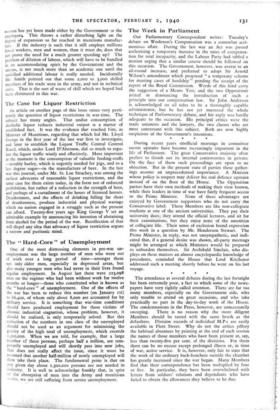The " Hard-Core" of Unemployment
One of the most distressing elements in pre-war un- employment was the large number of men who were out of work over a long period of time—amongst them not only older men, especially in depressed areas, but also many y6unger men who had never in their lives found regular employment. In August last there were 223,098 men on the register who had been without work for twelve months or longer—those who constituted what is known as the " hard-core " of unemployment. One of the effects of the war has been to reduce this number (on January 1st) to 86,400, of whom only about 8,000 are accounted for by military service. It is something that war-time conditions should have produced employment for these victims of chronic industrial stagnation, whose problem, however, it should be realised, is only temporarily solved. But this reduction of the numbers in one class of the unemployed should not be used as an argument for minimising the gravity of the high total of unemployment, which exceeds 1,300,000. When we are told, for example, that a large number of these persons, perhaps half a million, are tem- porarily unemployed and will shortly pass into new jobs, that does not really affect the issue, since it must be assumed that another half-million of newly unemployed will then take their place. The fundamental point is that on any given day about 1,300,000 persons are not needed in industry. It is well to acknowledge franldy that, in spite of the absorption of men into the Army and munitions Works, we are still suffering from severe unemployment.






































 Previous page
Previous page